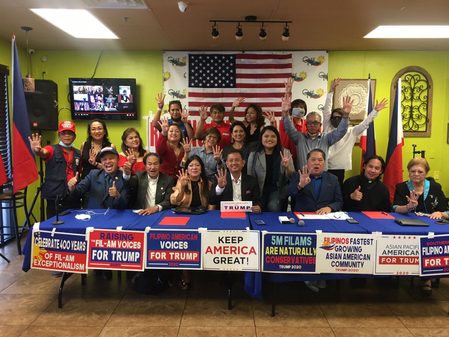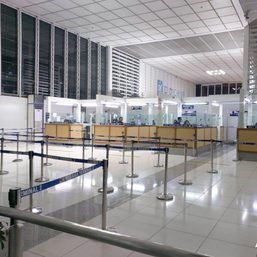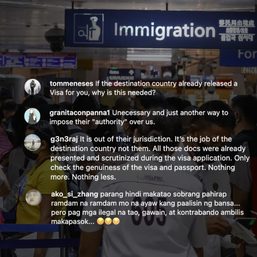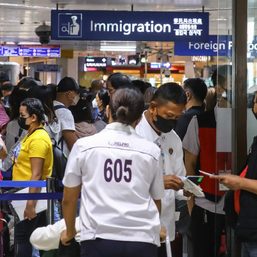SUMMARY
This is AI generated summarization, which may have errors. For context, always refer to the full article.
![[OPINION] Garbage time: The continuing crusade against immigration](https://www.rappler.com/tachyon/2020/12/ispeak-crusade-against-immigration-1280.jpg)
There comes a time in most basketball games when the outcome is pretty much decided, and all that’s left to decide are statistics. The players at the end of the bench finally get some playing time, and the crowd starts streaming out. The game gets less serious, but you still respect your opponent and the game. It’s frowned upon to run up the score, and valiant but sad to keep fighting for a lost cause.
If you thought the last two minutes of Trump’s term would follow established norms, then you haven’t been paying attention. Even as its captain continues to bother the referees and league commissioner to overturn the results of a blowout game, Team Trump is still pushing its extreme anti-immigration agenda across the board even in garbage time, still throwing out policy proposals like enforcers dealing out cheap shots.
While the president has been golfing, his minions have been busy at work, continuing their attacks at every point of immigration. The thing about the past 4 years – while they campaigned against illegal immigration, most of their work has been against legal immigration, which is down 49% compared to 2016. Contrary to propaganda, immigrants don’t take American jobs – we work jobs that Americans either don’t want to do or aren’t qualified for. The average annual labor force growth, which is a key economic indicator, is down 59% in the age of Trump.
Reasonable doubt
Although students are technically non-immigrants, you’ll find that people on many immigration forums across the web consider education to be the modern way of immigration. You study something specialized somewhere, then land a job or find investors for a startup business, then parlay that investment of tuition and years of your youth into a way to stay.
Immigration and education are both under attack, and in terms of education, it’s working – international student enrollment is down 72% this year. What it also does though is create a shortage the other way – international students who apply might be surprised to get into higher ranked colleges and universities than they might expect.
Who’s down with OPT?
After graduating from an American college, international students can usually apply for a year of Optional Practical Training. This grants them work authorization to work in fields related to their degrees. In real life, it’s a year for fresh graduates to find an employer willing to sponsor them, or to have a few months of vacation before going back home. Without the ability to stay and work for even a year, US colleges and universities would be less attractive to international students, who provide much of the funding to subsidize the scholarships of American students.
America has always had a shortage of workers in science, technology, engineering, and math, which still continues today, as those subjects are considered difficult and not popular amongst Americans. In 2008, during the Bush administration, international student graduates with “STEM” degrees were given the option to apply for STEM OPT, which initially lasted 17 months beyond the expiry of their original OPT. This was extended to 24 months under the Obama administration.
Between 2004 and 2016, more than half of the approximately 1.5 million F-1 students studied in STEM fields. Most STEM jobs in the US are filled by immigrants, with few willing or qualified Americans to replace them. A union of tech workers sued the Department of Homeland Security twice to stop both STEM OPT and even regular OPT for international student graduates. On December 1, the US District Court of the District of Columbia issued a summary judgement order upholding OPT, in a win for American higher education and all STEM-related industries in the US.
H-1B: Luck vs money
The next step in an employment or business immigration process is the H-1B, which is technically a dual intent visa that allows non-immigrants to have immigrant intent. While you don’t need to have graduated from a US institution to get an H-1B, you do need to have at least a bachelor’s degree related to the field you plan to work in, and the job must require a bachelor’s degree or higher credentials. Many healthcare and IT workers from the Philippines come to the US on H-1B, which ties you to a specific sponsoring employer. If you lose your job for any reason, you immediately become undocumented, unless you can find another sponsor and process another type of status right away.
Every first week of April, a lottery is held that distributes 85,000 H-1B visas, with 20,000 reserved for those with US master’s degrees or above, and 6,800 reserved for citizens of Singapore (5,400) and Chile (1,400), who have a separate H-1B1 based on free trade agreements signed with the US in 2004, during the Bush administration. The Trump administration changed the lottery in 2019. Instead of filing reams of paper, business immigration attorneys now file things electronically, with new forms and rules that work to slow down the process. Typically, people have about a 30% chance of winning the H-1B lottery, although this year, not enough visas were distributed in April, so a rare second H-1B lottery was held in August, distributing the remaining visas.
The Trump administration’s attack on H-1B this year was insidious – with two proposed rules, the first tightening the rules about “worksites” and “employers” – in a direct attack against IT professionals – who are often contracted out by their employers to work on the employers’ clients’ sites. The second proposed to change the rules for H-1B to favor higher salaries – basically setting up a bidding war where employers who bid the highest salaries could get H-1B workers, an interesting goal for an anti-immigrant administration. These proposals to change the rules of prevailing wage determinations were recently blocked nationwide by the US District Courts of Northern California, New Jersey, and DC.
Anti-immigrant moves in silence and bias
The final two steps in legal immigration are typically becoming a legal permanent resident and then naturalizing to US citizenship. These are under attack as well. On November 17, USCIS quietly proposed to increase its discretion in adjudicating applications for people adjusting status from other non-immigrant statuses to legal permanent residency.
Normally, these are pretty straightforward cases – if you have an employer or family-based sponsor and fulfill all of the many requirements, you apply for legal permanent residency and receive a green card, with most of the rights of US citizens other than voting. Green card holders can permanently work, reside, and travel in and out of the US, with few restrictions other than maintaining a clean criminal record. The proposal adds discretion into the process – asking the officers to consider applicants’ conduct, character, family, and other ties to the US, and only approving the green card if the officer feels like the positive factors outweigh any possible negative factors. This upends about 70 years of precedent, and adds an element of chaos, with the biases of individual officers having more bearing.
America calls itself the oldest democracy in the world, but…
Finally, aside from raising the prices for applications across the board (almost double for green card applications), the administration also changed the citizenship test. Before December 1 of this year, applicants for naturalization were given a list of 100 questions about US history and civics. During their citizenship exam, they would be asked up to 10 questions, and needed to get at least 6 right, along with fulfilling other requirements.
The new citizenship exam is 128 questions, with prospective citizens having to answer 12 of 20 questions correctly. More importantly, the correct answers to the civics questions were changed, with a significant conservative bias and many glaring errors. For example, instead of senators representing all the people of their state, the answer was changed to “all citizens,” excluding all legal permanent residents. It’s also riddled with mistakes – like saying the Federalist Papers influenced the Constitution when they were written after. The answer to the question about rights of everyone living in the US now excludes the rights to counsel, due process, equal protection, freedom from cruel and unusual punishment, and freedom from unreasonable search and seizure, and incorrectly stating that “everyone” has the right to bear arms, when people on visas and convicted felons don’t have that right. 11 of the 128 questions mention men by name, while only 1 mentions a woman. The new citizenship test is also obsessed with battles and wars and only mentions the word “democracy” once. These sample answers will be studied by millions of future citizens, not just making citizenship harder and more expensive to obtain, but incepting bias into their studies.
Overtime
While Biden has promised to make the US more welcoming to immigrants, there is much that is broken that will need fixing. With a raging pandemic and an economy shattered by Trump’s mismanagement, immigration may or may not be a priority. Most of the proposals so far have dealt with undocumented or illegal immigration, but the system has been slanted against legal immigrants in ways that will be difficult to unravel. Now more than ever, immigrants need to work harder to earn our way here, and show and prove that we are here to stay. More than half of America’s Fortune 500 companies were founded by first- or second-generation immigrants. America was founded as a land of immigrants, and immigrants are the ones who make America great. – Rappler.com
Jath Shao is an immigration attorney who helps people achieve the American Dream. Originally from Manila’s Chinatown, he speaks several languages and understands the joys and pains of immigrant life.
Add a comment
How does this make you feel?


![[Just Saying] Reasons the new travel regulations are flawed](https://www.rappler.com/tachyon/2023/08/TL-travel-regulations-August-31-2023.jpg?resize=257%2C257&crop=281px%2C0px%2C720px%2C720px)



There are no comments yet. Add your comment to start the conversation.